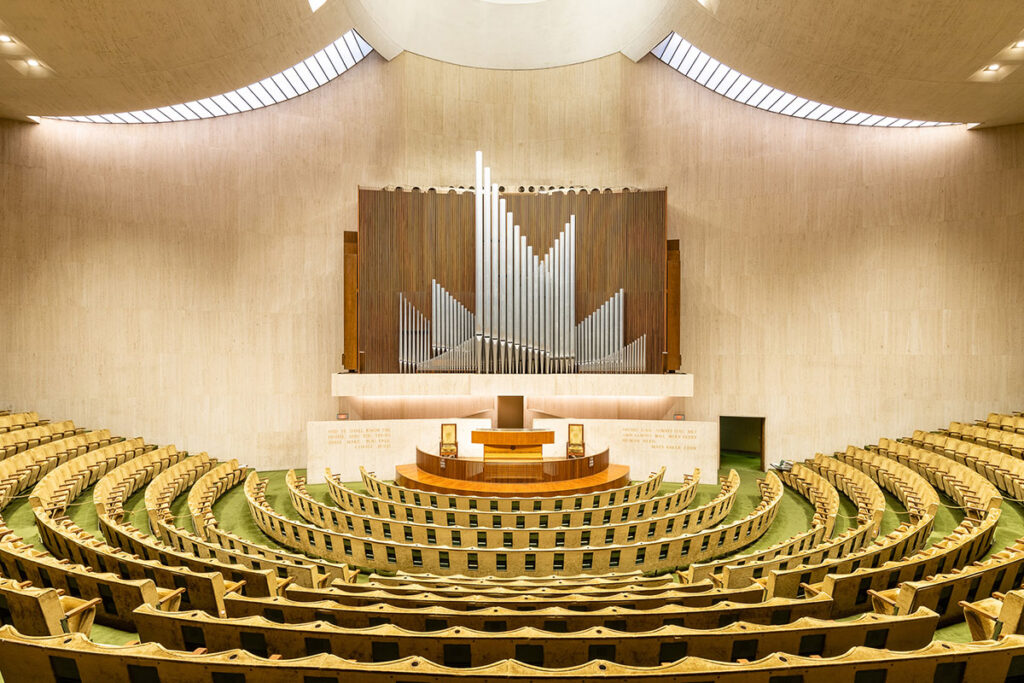Two projects demonstrate this designer’s approach to bringing back historic spaces
By Avraham Mor

SEVENTEENTH CHURCH
The Seventeenth Church of Christ, Scientist is an iconic part of Chicago’s downtown landscape, and a piece of the city’s architectural history. The house of worship’s curvilinear façade, designed by architect Harry Weese to echo a Greek amphitheater, has gracefully marked the corner of Wacker Drive and Wabash Avenue since 1968. Recognized as one of Illinois’s 200 Great Places by the American Institute of Architects Illinois, the Seventeenth Church is a modernist treasure.
When Morlights was hired to upgrade the church’s lighting and controls, both were in their original state, except for a few LED replacement lamps, which yielded insufficient, lackluster illumination. The exterior lighting was mostly nonfunctional. Our master plan was budgeted over a three-year completion period with minimal downtime for construction, during which the firm acted as both lighting designer and project manager. Using extensive modeling in place as well as detailed, photometrically accurate renderings to verify light levels and optics on both the interior and exterior, Morlights leveraged LED technology and a new DMX control system to execute the renovation.
Highlights of the interior architecture, including the striking podium, dome and skylights, were beautifully articulated, and a shift to linear fixtures allowed a smooth wash of light on the lower parapet. Energy use was reduced by 50%; DMX controls now allow seamless adaptability. And outside, RGBW LED lighting allows the Church to join in when the city lights up its skyline in themed color, keeping this icon in conversation with its setting.
As designers, we’re always thrilled and honored when the all-too-rare opportunity to work on historically significant spaces comes our way. So, while it’s challenging and fun to oversee the lighting and design of a space from rendering to construction and grand opening, revamping and refreshing historically significant spaces holds a special place in our hearts here at our firm.
Our goal is never a complete overhaul of the space; after all, the architectural bones and design details are often what makes historic buildings so special and iconic. Our preference is always that at the completion of our work, the project looks exactly as it did when it was first built—only illuminated in better and more efficient light. Here in Chicago, a city with such a rich history, the opportunity to transform historical spaces and write new chapters of their story is one of the highlights of our work. Two landmarks come to mind when we think of ways we have revamped historic spaces: the Seventeenth Church of Christ, Scientist and the Chicago Central Post Office.

CENTRAL POST OFFICE
The Chicago Central Post Office, on the other hand, had a bit more retrofitting involved. The space was built in 1974, as part of Mies van der Rohe’s iconic three-building General Services Administration complex located in the Loop. The post office had seen a refresh prior to Morlights’ involvement, where HID lights, which were considered energy-efficient at the time, were installed. Once we joined the project, we immediately looked at reducing energy consumption, but unfortunately, could not replace HIDs with tried-and-true LEDs, since they could not meet the light-level requirements for the post office. Instead, we turned to 4-pin CFL lamps and a DALI control system to both take advantage of daylight contribution and reduce energy use.
Not only that, but by doing some research, we were able to restore the original Mies van der Rohe detail at the downlights, something that had been lost over time. The Chicago Central Post office is the only space that maintains this detail to date. We do foresee the introduction of updated LEDs coming soon, though…stay tuned.
Three History Lessons
Here are the author’s three most important considerations when lighting a historically significant space. Think about these next time you set foot in a landmark building in your city:
- Respect the history and choices made when the project was built: There are reasons for most things, so regardless of what they were (sometimes it’s simply “this solution was cheaper”), understanding and respecting the decisions made when a project was built or updated is key.
- Watch out for finishes: When you start changing lighting, you will change the way materials and finishes are rendered. My biggest piece of advice on maintaining the original finishes is to mock up your choices so you can confirm the finishes will render as desired.
- Do the research: Digging for documents, photos, old drawings and whatever else you can find will shine so much light on the thought process behind what was done, and even inspire more ideas as to what could be done now. Do the work and I promise it will make the outcome better.


